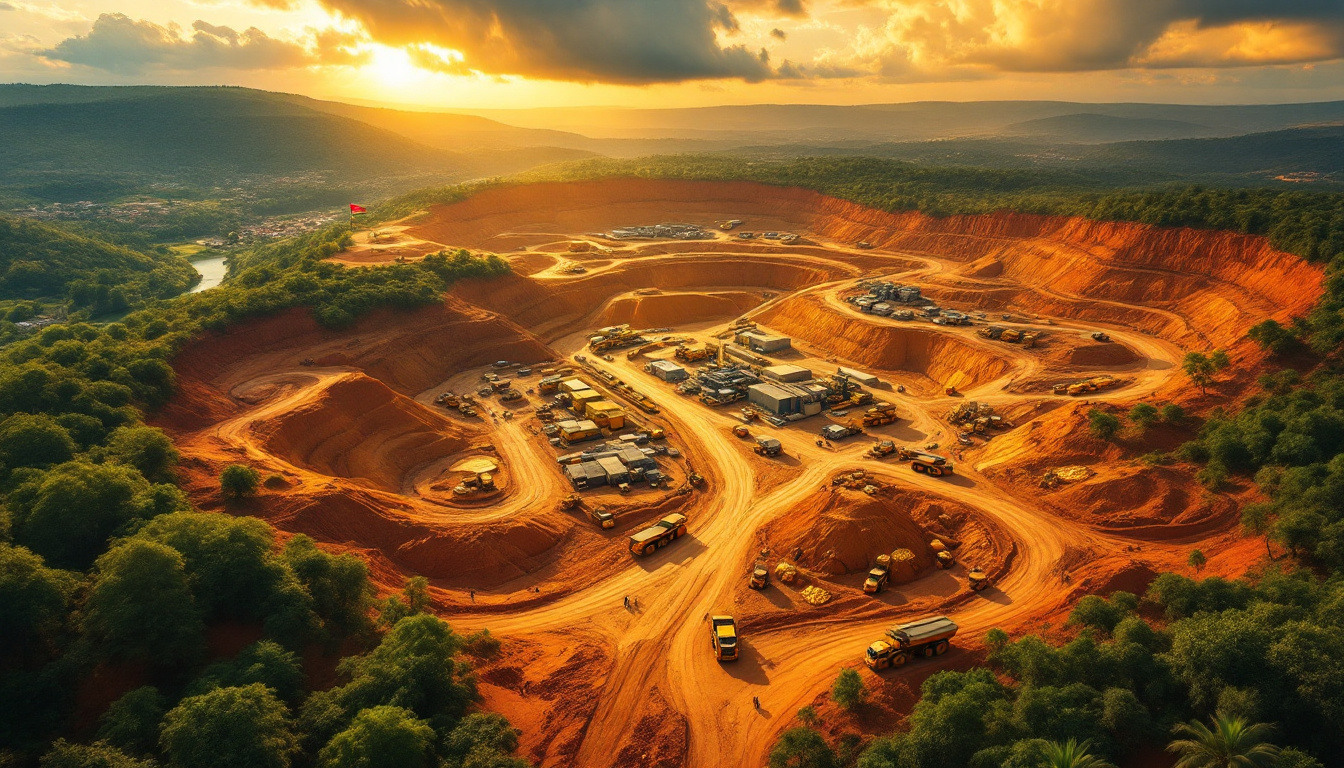The World’s Ten Largest Gold Mines in 2025: A Global Production Ranking
Understanding Global Gold Mining Production
The Scale of Gold Mining Operations Worldwide
The global gold mining industry represents one of the most expansive resource extraction sectors in the world. According to GlobalData’s comprehensive mining database, over 1,352 active gold mines currently operate across more than 150 countries, processing in excess of 100 different commodities. This vast operational network underpins the approximately 3,000 metric tons of gold produced annually worldwide.
Production volumes for gold mines are typically measured in ounces, with the elite tier of mines producing well over 1 million ounces annually. This extraordinary output represents not just technical achievement but geological fortune—the convergence of deposit quality, operational excellence, and sustained capital investment. Recent gold market analysis and investment insights for 2024–2025 suggest continued stability in production from these major operations.
How Gold Mine Production Is Measured
Gold mine productivity is primarily measured through annual production volume, reported in troy ounces. Industry analysts classify mines according to their extraction methodology—surface (open-pit), underground, or combined operations—each presenting unique engineering challenges and cost structures.
Mines are further categorized as either brownfield (existing operations with expansion potential) or greenfield (newly developed sites), reflecting their development stage and investment profile. The operational lifespan of major gold mines varies significantly, with the top producers expected to remain active from 2031 (Cortez Mine) to as far as 2049 (Lihir Mine), according to mining analysts.
What Makes a World-Class Gold Mine?
Key Characteristics of Top-Producing Gold Mines
World-class gold mines share several distinctive attributes that separate them from the thousands of smaller operations worldwide. Consistent annual production exceeding 500,000 ounces represents the entry threshold for elite status, though the largest operations produce three to four times this amount.
These premier operations deploy advanced extraction technologies enabling recovery rates often exceeding 90%, compared to industry averages closer to 70%. Strategic geographic positioning atop exceptional geological formations with high-grade ore bodies provides the foundation for sustained production.
Most top-tier mines boast operational lifespans exceeding a decade, with many approaching or exceeding quarter-century timelines. Perhaps most critically, these operations demonstrate remarkable resilience, maintaining production volumes and profitability despite gold price fluctuations that have ranged from $1,050 to $2,400 per ounce in recent years.
Ownership Patterns Among Leading Gold Mines
The world’s largest gold mines display a concentrated ownership structure dominated by a handful of major mining corporations. Barrick Gold Corporation operates 4 of the 10 largest gold mines globally, representing approximately 4 million ounces of annual production capacity. Newmont Corporation controls 2 of the top 10 producing mines, contributing about 1.5 million ounces to their portfolio.
State-owned enterprises maintain significant presence in the top tier, with entities like Navoi Mining & Metallurgy Combinat (Uzbekistan) and Mining Industry Indonesia operating some of the world’s most productive gold mines. This ownership concentration reflects both the capital-intensive nature of large-scale mining and the strategic importance governments place on controlling gold production assets. In many cases, why gold stocks may not reflect true production performance comes down to these complex ownership structures.
10. Loulo-Gounkoto Mine
Location and Ownership
The Loulo-Gounkoto complex is situated in the Kayes region of western Mali, approximately 350 kilometers northwest of the capital Bamako. This brownfield operation is owned and operated by Barrick Gold Corporation, which maintains an 80% controlling interest, with the remaining 20% held by the Government of Mali.
Production Statistics and Operational Details
The mine produced 683,750 ounces of gold in 2023, representing approximately 1.6% of global mine supply. Geological assessments project continued operations until 2037, providing significant long-term economic benefits to Mali. The complex uniquely combines both surface and underground mining techniques, allowing for optimal extraction across varying geological conditions.
What distinguishes Loulo-Gounkoto is its consistent production despite operating in a region challenged by political instability and security concerns, demonstrating Barrick’s risk management capabilities in complex jurisdictions.
9. Kibali Mine
Location and Ownership
Kibali Mine is located in the Orientale Province of northeastern Democratic Republic of the Congo, approximately 560 kilometers northeast of Kisangani. This greenfield development is operated by AngloGold Ashanti, which shares ownership with Barrick Gold (each holding 45%) and state-owned Société Minière de Kilo-Moto (10%).
Production Statistics and Operational Details
In 2023, Kibali yielded 762,220 ounces of gold, securing its position as Africa’s second-largest gold mine. The operation is expected to continue through 2036 based on current reserve estimates. Kibali employs both surface and underground mining methods, with the underground portion utilizing one of Africa’s most sophisticated automated materials handling systems.
The mine represents a remarkable engineering achievement, having been developed in an extremely remote location that required construction of significant infrastructure, including a 42-megawatt hydroelectric power system that provides 75% of the mine’s energy needs—an unusual sustainability feature for African mining operations.
8. Pueblo Viejo Mine
Location and Ownership
Pueblo Viejo is situated in the Sánchez Ramírez Province of the Dominican Republic, approximately 100 kilometers northwest of Santo Domingo. This brownfield surface mining operation is owned by Barrick Gold (60%) and Newmont Corporation (40%).
Production Statistics and Operational Details
The mine produced 767,150 ounces of gold in 2023, with operations projected to continue until 2040. Pueblo Viejo stands as one of the largest foreign investments in the Dominican Republic’s history, contributing approximately 3.5% of the country’s GDP.
What makes Pueblo Viejo particularly notable is its processing capabilities for handling double refractory ore—a technically challenging material requiring specialized processing techniques. The mine employs pressure oxidation technology to unlock gold from sulfide minerals, representing one of the most advanced metallurgical operations in the gold mining industry.
7. Lihir Mine
Location and Ownership
Lihir Mine occupies a portion of Lihir Island in New Ireland Province, Papua New Guinea, situated approximately 900 kilometers northeast of Port Moresby. This surface mining operation is wholly owned by Newmont Corporation following its acquisition of Newcrest Mining.
Production Statistics and Operational Details
In 2023, Lihir produced 780,000 ounces of gold, with an exceptionally long operational timeline extending to 2049—the longest projected lifespan among the world’s ten largest gold mines in 2023. This extraordinary longevity stems from Lihir’s unique geological setting: the mine operates within an extinct volcanic crater, accessing one of the world’s largest gold deposits.
The operation has overcome significant technical challenges, including managing geothermal activity with temperatures exceeding 150°C in parts of the deposit. Lihir’s processing facilities include the world’s largest autoclave for pressure oxidation of refractory ore, enabling recovery from complex mineralization that would be uneconomical with conventional technologies.
6. Boddington Mine
Location and Ownership
Boddington Mine is located in Western Australia, approximately 130 kilometers southeast of Perth. This brownfield surface mining operation is wholly owned by Newmont Corporation, which acquired it through its merger with Goldcorp.
Production Statistics and Operational Details
The mine delivered 786,170 ounces of gold in 2023, cementing its position as Australia’s largest gold producer by volume. Operations are expected to continue until 2036 based on current reserve estimates.
What distinguishes Boddington is its dual nature as both a gold and copper producer, with significant copper production creating valuable by-product credits that improve overall economics. The mine also pioneered the implementation of autonomous haulage technology in Australian gold mining, deploying a fleet of driverless trucks that increase operational efficiency and safety. Australia’s gold mining heritage runs deep, with Kalgoorlie’s golden streets: the story of Australia’s richest gold rush town illustrating the historical significance of gold mining in the country.
5. Grasberg Block Cave Mine
Location and Ownership
The Grasberg Block Cave operation is situated in Papua Province, Indonesia, amid the rugged highlands at elevations exceeding 4,000 meters. This brownfield underground mining operation is owned by state-controlled PT Indonesia Asahan Aluminium (51.24%) through Mining Industry Indonesia, with Freeport-McMoRan holding the remaining 48.76%.
Production Statistics and Operational Details
In 2023, Grasberg produced 937,610 ounces of gold as a by-product of its primary copper operations. The mine is expected to continue production until 2041. Notably, Grasberg represents a transition from what was once the world’s largest open-pit mine to an entirely underground operation—one of the most ambitious mine conversions ever undertaken.
The operation is unique among major gold producers as gold represents a secondary product to copper, with the site ranking as one of the world’s largest copper producers. The block cave mining method employed at Grasberg utilizes natural gravitational forces to fracture and extract ore, representing mining engineering at its most sophisticated scale.
4. Cortez Mine
Location and Ownership
Cortez Mine is located in northeastern Nevada, United States, approximately 100 kilometers southwest of Elko along the prolific Carlin Trend. This brownfield operation combines both surface and underground mining techniques and is owned by Nevada Gold Mines—a joint venture between Barrick Gold (61.5%) and Newmont Corporation (38.5%).
Production Statistics and Operational Details
The complex produced approximately 1 million ounces of gold in 2023, with operations expected to continue until 2031. What separates Cortez from many competitors is its exceptionally high-grade underground sections, particularly the Deep South and Goldrush deposits, where ore grades can exceed 10 grams per tonne—roughly five times the global average.
Cortez pioneered many of the extraction and processing techniques now standard for handling carbonaceous refractory ores found throughout Nevada. The operation demonstrates the evolution of mining in mature districts, transitioning from initial surface operations to increasingly sophisticated underground developments targeting deeper, higher-grade mineralization.
3. Olimpiada Mine
Location and Ownership
Olimpiada Mine is situated in the remote Krasnoyarsk Krai region of Siberia, Russia, approximately 400 kilometers north of Krasnoyarsk city. This brownfield surface mining operation is wholly owned by Polyus, Russia’s largest gold producer.
Production Statistics and Operational Details
In 2023, Olimpiada yielded approximately 1.17 million ounces of gold, solidifying its position as Russia’s largest gold mining operation. The mine is projected to remain active until 2035 based on current reserve estimates.
What makes Olimpiada particularly notable is its ability to maintain high production rates despite extremely challenging operational conditions, including winter temperatures that routinely plunge below -40°C. The operation processes double-refractory ore through bacterial oxidation—a biotech approach to metallurgy that employs specialized microorganisms to liberate gold from sulfide minerals.
2. Carlin Mine
Location and Ownership
The Carlin Mine complex spans a significant portion of Nevada’s Carlin Trend, approximately 40 kilometers northwest of Elko, United States. This operation combines multiple interconnected surface and underground mines operated by Nevada Gold Mines, the Barrick-Newmont joint venture.
Production Statistics and Operational Details
In 2023, the Carlin complex produced approximately 1.59 million ounces of gold, with operations expected to continue until 2032. The Carlin Trend itself represents one of geology’s most remarkable gold concentrations—a 50-mile belt containing more than 180 million ounces of gold discovered since initial development in 1965.
The operation’s significance extends beyond production volumes; Carlin-type deposits have become a geological classification in their own right, with similar formations sought worldwide. The complex employs multiple processing technologies, including roasting, pressure oxidation, and heap leaching, to extract gold from varying ore types—representing one of mining’s most comprehensive metallurgical operations.
1. Muruntau Mine
Location and Ownership
Muruntau Mine dominates the landscape near Zarafshan city in Navoiy Province, central Uzbekistan. This greenfield surface mining operation is owned and operated by Navoi Mining & Metallurgy Combinat, a state-owned enterprise of Uzbekistan.
Production Statistics and Operational Details
With estimated production of 1.8 million ounces in 2023, Muruntau stands unchallenged as the world’s largest gold mine by production volume. Operations are projected to continue until at least 2032, though ongoing exploration may extend this timeline.
What truly distinguishes Muruntau is its scale—the open pit measures approximately 3.5 kilometers by 2.5 kilometers with a depth exceeding 600 meters, making it one of the largest excavations on Earth. Perhaps more remarkable is the deposit’s exceptional grade consistency, with substantial portions maintaining grades above 2.4 grams per tonne across massive volumes—an extremely rare combination in gold mining.
The operation employs one of the world’s most extensive conveyor systems, stretching over 3.5 kilometers, to transport ore from the pit depths to processing facilities. Despite its remote location, Muruntau achieves production costs significantly below industry averages, cementing its position as not just the largest but potentially the most profitable gold mine globally.
Geographic Distribution of Top Gold Mines
Regional Concentration of Major Gold Production
The world’s top gold mines display a surprisingly balanced global distribution, with no single region dominating production. North America hosts 3 of the top 10 mines, all located in the United States, collectively representing approximately 3.6 million ounces of annual production.
Africa contributes 2 operations to the top tier (in Mali and Democratic Republic of Congo), producing approximately 1.45 million ounces annually. Asia likewise claims 2 positions (in Uzbekistan and Indonesia) with the highest combined regional production at approximately 2.7 million ounces.
Oceania places 2 operations among the leaders (in Australia and Papua New Guinea), contributing approximately 1.57 million ounces, while Latin America registers a single representative in the Dominican Republic, producing 767,150 ounces annually. According to the latest global gold production data, these patterns have remained relatively stable in recent years.
How Production Capacity Varies by Region
Central Asian operations, represented solely by Uzbekistan’s Muruntau Mine, lead with the highest single-mine production capacity at 1.8 million ounces annually—a testament to the exceptional geology of the Kyzylkum Desert region. North American operations, concentrated entirely in Nevada’s Carlin Trend, collectively account for 2.59 million ounces from top-ranked mines.
African operations contribute 1.45 million ounces from top-ranked mines, though the continent’s full production potential remains underdeveloped due to infrastructure limitations and political risk factors. What’s particularly notable is how the geographic distribution of elite mines differs substantially from overall gold production by country, where China’s Wangu gold field: a paradigm shift in global gold markets is changing the landscape despite having no individual mines in the global top 10.
FAQ: Understanding Global Gold Mine Production
What factors determine a gold mine’s production capacity?
A gold mine’s production capacity stems primarily from five interconnected factors. The size and grade of the gold deposit establish the fundamental resource potential, with higher grades allowing profitable extraction from smaller volumes. The mining method employed—whether surface, underground, or combined operations—determines how quickly ore can be accessed and at what cost structure.
Processing technology and recovery rates dictate what percentage of contained gold is ultimately extracted from mined material, with advanced operations often achieving recovery rates exceeding 90%. Operational efficiency and the scale of mining equipment, particularly in open-pit operations where haul trucks can move up to 400 metric tons per load, directly impact throughput capacity.
Finally, sustained investment in mine development and expansion allows operations to maintain production levels as initial high-grade zones are depleted. Elite operations typically reinvest 15-20% of revenue into development to sustain long-term production capacity.
How do gold mining operations impact local economies?
Major gold mines generate profound economic impacts beyond their production statistics. Employment creation typically ranges from 2,000-5,000 direct jobs at large operations, with an additional 3-5 indirect jobs created in surrounding communities for each direct position.
Tax revenue for host countries often represents a significant fiscal contribution, with leading operations generating hundreds of millions in annual tax payments—in some cases exceeding 5% of national tax receipts in smaller economies. Infrastructure development accompanying mining operations frequently includes power generation facilities
Want to Identify the Next Major ASX Gold Discovery?
Discover potentially transformative gold opportunities before the broader market with Discovery Alert’s proprietary Discovery IQ model, which delivers real-time alerts on significant ASX mineral discoveries and turns complex data into actionable insights. Explore why major mineral discoveries can lead to substantial market returns by visiting Discovery Alert’s dedicated discoveries page.




